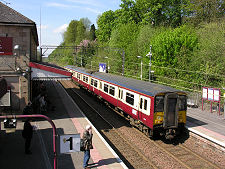 Principal Rail Routes in Scotland Note About Image Copyright |
The rail network in Scotland has survived into the Third Millennium in a rather healthier state than in many other parts of the UK. As a result railway travel continues to be a realistic option across a surprisingly large proportion of the country, and Scotland is well placed to develop the network further as demand continues to grow for sustainable travel. One result is that several new railway lines in Scotland have been opened in recent years.
Things could easily have worked out differently. Although many Scottish railway lines deemed uneconomic were closed during the UK-wide "Beeching" cuts of the 1960s, the overall impact was far less severe than experienced in much of England, and the full extent of the Beeching proposals for cuts were never carried through here. If they had been, no railway lines would today extend north or west of Inverness, and the West Highland Line would be nothing but a fading memory.
Scotland also did rather better, or less badly, than most parts of the UK when British Rail was privatised in the mid 1990s. The process chosen was enormously complex, with the track and infrastructure being owned by one company, and rolling stock being owned by a number of other companies. The actual operation of train services fell to a third group of companies, who competitively bid for them, with the successful ones then running a particular set of services by leasing the rolling stock from one company and paying another for use of the tracks and stations. Franchising was carried out by one UK government agency, while another regulated the industry and oversaw safety. Lewis Carroll, the author of Alice's Adventures in Wonderland, would have been hard-pressed to come up with anything nearly as bizarre.
The worst effects of all this were avoided north of the border because all railway services running entirely within Scotland were operated by a single company. As a result, coordination of services within Scotland has been relatively effective. This company also operates the sleeper service providing an overnight link between London and five Scottish stations, Aberdeen, Edinburgh, Fort William, Glasgow and Inverness.
Other "cross-border" services are operated by other companies. The East Coast Main Line from London via Peterborough, Doncaster, York, Newcastle and Berwick goes on to Edinburgh, with some trains carrying on to Glasgow, Inverness or Aberdeen. Meanwhile there are also cross-country services from south-west England through Birmingham and York to Edinburgh: and the West Coast Main Line passes through Birmingham, Crewe and Preston en route to the Scottish Border from London, before continuing to Glasgow.
Within Scotland, the greatest density of routes and services lies within the Central Belt. Glasgow has the UK's second largest suburban railway network after London, and the generally very good services throughout Scotland's most populated area improved still further with the rebuilding of a "missing link" allowed a new set of direct services to begin between Edinburgh and Glasgow, using lines that pass through the towns along the M8 corridor.
South of the Central Belt, trains are usually seen as fast moving objects en route from the English border to Edinburgh or Glasgow, though the Glasgow South-Western Line does carry services to Ayr and Stranraer, and to Carlisle. And the Borders Railway opened in 2015 to serve part of the Scottish Borders from Edinburgh to Galashiels.
In northern Scotland lines link the Central Belt via Perth and Dundee with Inverness and Aberdeen. From a visitor's point of view, however, the real attraction of Scotland's railways comes from the survival of the lines to the north and west that might have been lost in the 1960s.
The best known of these is the West Highland Line. From a starting point in Glasgow's Queen Street Station, this heads north-west along the shore of Loch Long before taking a route above the west shore of the northern half of Loch Lomond. At Crianlarich the line splits. Some services head west through Lower Tyndrum Station and Dalmally before passing along the north shore of Loch Awe en route to a terminus at Oban. More scenic still is the track that heads from Crianlarich to Upper Tyndrum Station before turning north to take a remote route, far from the line of the road, across Rannoch Moor, then coming round through Spean Bridge to Fort William. From there the West Highland Line heads west to its terminus at the fishing and ferry port of Mallaig, along a stretch of railway considered by many to be the most beautiful in the world.
The scenic Kyle of Lochalsh Line runs from Inverness north-west to Achnasheen, then south-west, past Strathcarron and Plockton to its destination at Kyle of Lochalsh. This was once the ferry port for Skye and now stands close to the mainland end of the Skye Bridge.
The most remote of Scotland's railways is the Far North Line, which follows a twisting line north from Inverness and travels deep inland to Lairg in central Sutherland en route to Thurso and Wick. With journey times of up to 4½ hours from Inverness to Wick, this isn't a journey for those in a hurry: but you probably came to Scotland to get away from being in a hurry, so sit back, enjoy the scenery and, to use a pre-privatisation British Rail advertising slogan, "let the train take the strain".





